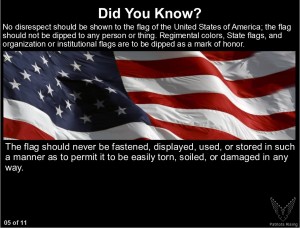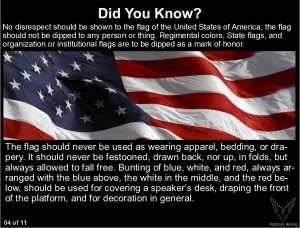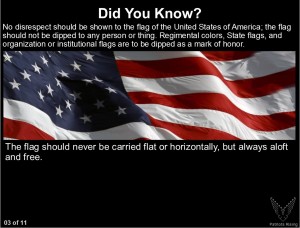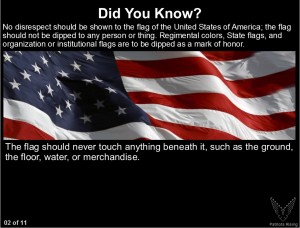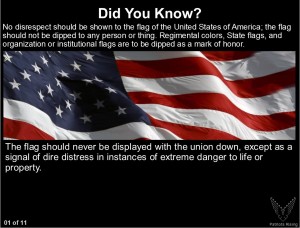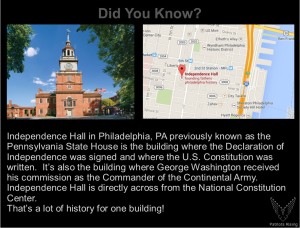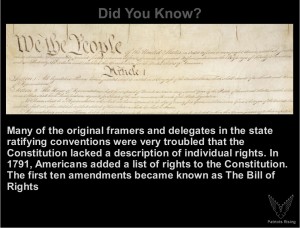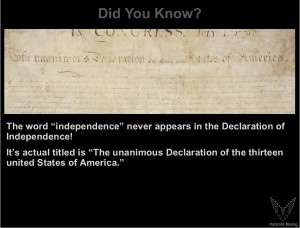Category Archives: Did You Know?
Facts and trivia from American History
United States Flag – Respect 04-11
United States Flag – Respect 03-11
United States Flag – Respect 02-11
United States Flag – Respect 01-11
Independence Hall
Did You Know?
Independence Hall in Philadelphia, PA previously known as the Pennsylvania State House is the building where the Declaration of Independence was signed and where the U.S. Constitution was written. It’s also the building where George Washington received his commission as the Commander of the Continental Army. Independence Hall is directly across from the National Constitution Center. That’s a lot of history for one building!
Bill of Rights and the Constitution
Where’s Independence?
Did You Know?
The word “independence” never appears in the Declaration of Independence!
It’s actual titled is “The unanimous Declaration of the thirteen united States of America.”
Transcript of the Declaration of Independence
Image of the Declaration of Independence
It could never happen here!
Did you Know?
History can teach us so much if we simply step back and listen. Many of the horrific events in our past seemed at the time needed, possibly a necessity for progress or even to secure our nation’s security. We later look back to find our noble and logical ideas were flawed and influenced by greed and fear.
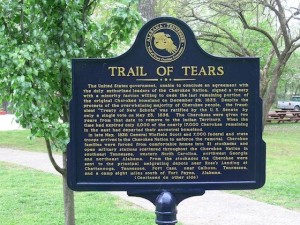 President Andrew Jackson on May 28, 1830 signed into law The Indian Removal Act which authorized the president to negotiate with Indian tribes in the southern United States for their ancestral homelands which fell within state lines. In return the United States would grant them land rights west of the Mississippi. Many tribes relocated peaceably but other refused. Those that refused were later forcibly relocated by the United States government and later became known as the “Trail of Tears”, where thousands died from exposure, exhaustion and mal-nutrition.
President Andrew Jackson on May 28, 1830 signed into law The Indian Removal Act which authorized the president to negotiate with Indian tribes in the southern United States for their ancestral homelands which fell within state lines. In return the United States would grant them land rights west of the Mississippi. Many tribes relocated peaceably but other refused. Those that refused were later forcibly relocated by the United States government and later became known as the “Trail of Tears”, where thousands died from exposure, exhaustion and mal-nutrition.
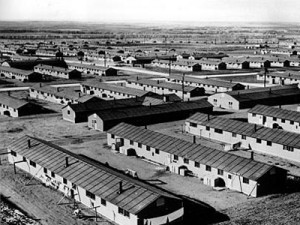 President Franklin D. Roosevelt on February 19, 1942 authorized the incarceration and relocation of American citizens with an Executive Order. During World War II approximately 120,000 Japanese Americans (62% were US Citizens) were incarcerated and forced to relocate to internment camps. It was later determined in 1980 by an investigation opened by President Jimmy Carter that the Japanese American’s incarcerated showed little if any disloyalty to the United States and that the major motivator was racism and free.
President Franklin D. Roosevelt on February 19, 1942 authorized the incarceration and relocation of American citizens with an Executive Order. During World War II approximately 120,000 Japanese Americans (62% were US Citizens) were incarcerated and forced to relocate to internment camps. It was later determined in 1980 by an investigation opened by President Jimmy Carter that the Japanese American’s incarcerated showed little if any disloyalty to the United States and that the major motivator was racism and free.
Supreme Court Justice Antonin Scalia on February 3, 2014 responded to a room full of law students and faculty “but you are kidding yourself if you think the same thing will not happen again” in response to a question about the Japanese American internment camps during World War II. He continued “That’s what happens, it was wrong, but I would not be surprised to see it happen again, in time of war. It’s no justification, but it is reality.”
Patriots Rising
DONT TREAD ON ME
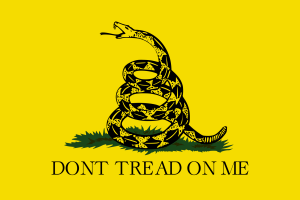 The Gadsden flag was designed in 1775 during the American Revolution war by American General Christopher Gadsden. The historic flag depicting a coiled rattlesnake ready to strike on a field of yellow with the words “Don’t Tread on Me” is considered to be one of the first flags of the United States.
The Gadsden flag was designed in 1775 during the American Revolution war by American General Christopher Gadsden. The historic flag depicting a coiled rattlesnake ready to strike on a field of yellow with the words “Don’t Tread on Me” is considered to be one of the first flags of the United States.
The first known use of a snake as a symbol of the American colonies can be traced back to Benjamin Franklin when he published a satirical commentary in the Pennsylvania Gazette in 1751. His article in the Pennsylvania Gazette suggested the colonists send rattlesnakes to England as a way of thanking the British for sending convicted felons to America. Three years later in 1754 Benjamin 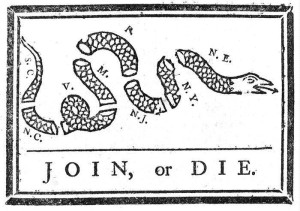 Franklin used the snake again in a less humorous manner. In the very first political cartoon published in an American newspaper Benjamin Franklin illustrated a snake cut into eight sections. The sections represented the individual colonies with the words “Join, or die” underneath.
Franklin used the snake again in a less humorous manner. In the very first political cartoon published in an American newspaper Benjamin Franklin illustrated a snake cut into eight sections. The sections represented the individual colonies with the words “Join, or die” underneath.
The Gadsden flag with its many variations has been used throughout our history as a symbol of American patriotism, independence and freedom.

